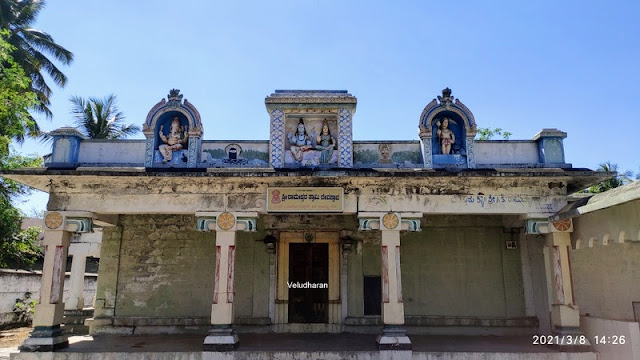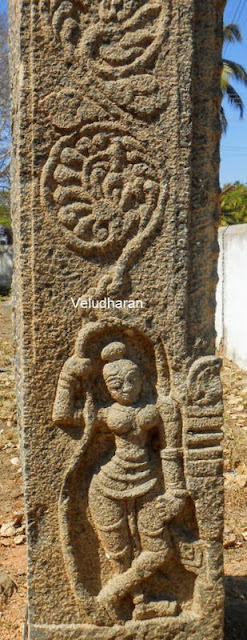The visit to this temple at Agara was a part of our
Chozha period temples Visit on the ancient trade route from Chamarajanagar to
Kollegal (Gangapadi), in Karnataka State. Agara.-Agara, a village in the
Yelandur taluk in the Mysore District. Population 4,261. It has four old
temples dedicated to Ramesvara, Narasimha, Varadaraja, and Durga. Except
Varadharaja temple the others were renovated during recent years.
In the Tamil inscriptions, the village is named
Durgaiyur- Agaram, and in the Kannada Durgagrahara, thus showing that it derived
its name from the goddess Durga of the place, though latterly the first portion
was left out and the place came to be known as merely Agara. It will be seen
from the Kannada and Tamil names of the village as given in the inscriptions
that Agara is only a Tamil corruption of the Sanskrit agrahara.
Moolavar :
Sri Rameswara.Consort :
Sri Parvata Vardhini
Some of the Salient features of this temple
are.....The temple faces east with a Rajagopuram base Pillars. The Pillars have the bas-reliefs of Ganga
& Yamuna (Kodi penkaL). A balipeedam is in front of the Sanctum Sanctorum. Stucco
images of Lord Shiva with Parvati, Vinayagar, and Murugan are on the top of the
front mandapam. In prahara Nagars,
Dakshinamurthy, Navagrahas, Chandikeswarar and Hanuman. Ambal is in a separate
sannidhi on the left side of the main temple - Moolavar. An anthill with Nagars
is in front of the Ambal sannadhi.
In the navaranga/ardha mandapa of the Tiruviramisvara
temple, which has two entrances with porches on the east and south, are kept figures
of Surya, Ganapati, Chandesvara, Virabhadra, Narayana, and Dakshinamurthy. The Dakshinamurthy
is a seated figure, about two feet high, bearing a snake, an antelope, and a
book in three hands, In a shrine the remaining hand being in the abhaya hastam.
In a shrine in the prahara is the goddess of the
temple, known as Parvata vardhini, a standing figure, about five feet high,
with four bands, the upper hands holding a noose/pasam and an elephant-goad/angusam, and the lower in the varada and abhaya hastam. This goddess is similar
to the one in the Gangadharesvara temple at Turuvekere.
ARCHITECTUREThe temple consists of sanctum sanctorum,
antarala, artha mandapam and a mukha mandapam. A two-tier vimana is over the
sanctum. The temple was reconstructed in recent years without disturbing
the padabandha Adhisthana. The inscriptions are found on the adhisthana.
Kodipen & Dwarapalaka reliefs on Pillars
HISTORY AND INSCRIPTIONSThe original temple was
believed to be constructed during Kulothunga Chozha-I, period. There are about 50 inscriptions recorded from
this temple. The inscriptions belong to Vira Someswara Deva, Vira Vallalan,
Vira Pratapa Chakravarthi etc. The
lineage of Vira Vallalan is Vira Ballala-I – VishnuVardhana – Narasimhan-I, –
Vira Ballalan–II – Vira Narasimha-II – Vira Someswara – Narasimha-III – Vira
Ballala-III. All the Kings Contributed to this temple.
As per the inscriptions
Lord Shiva was called Tiruviramisvaram-Udaiyar and this place was called Virudharaja bayangara Chathurvedi Mangalam also called Durgaiyur Agara,
which is now called Agara.
The Ramesvara temple has also several inscribed slabs
scattered in the compound, and several more built into the roof of the shrine of the
goddess. Fragments that have fallen from the walls have been replaced by
others, thus adding considerably to the difficulty of decipherment. The
displacement of the stones, even of the basement in some places, leads to the
conclusion that the temple must have undergone restoration at some former time.
The oldest record here seems to go back to the 11th century. It is believed that Thayar Sannidhi was closed due
to the threat of snakes.
The 13th
Century inscription records the endowment of grant of lands to the god
Tiruviramisvaram-Udaiyar by Manchapovan after purchase from Siman. It also
records the gift of 6 gadayanas from out-of-tax income for celebrating the Panguni
Uthiram festival.
A 13th
Century inscription records the grant of 100 kuli land along with the tax income
by Nachiyar who purchased 200 gadayanas from Siyagan from out of his share
of 200 kuli for burning perpetual lamp to the deity Tiruviramisvaram-Udaiyar.
A Fragmentary
inscription records the gift of gold for burning a perpetual lamp, and the same
was received by the Koil Stanapatigal.
The slightly
damaged 13th Century inscription records the rule of Viravallaladeva,
it also records Kuttadudevar, Danayakar, Malianan, Ganganan, and others the head
of 6 religions, met at the Tirukavanam of the temple of
Tiruviramisvaram-Udaiya-Nayanarand gave an undertaking to the mahajanas, who
endowed the wet and forest lands in the village Kungar as devadana to god Durgaiyur-agaram.
The boundaries of the lands are
specified. Also, the signatories of the grant like the Dannayaka and Malliyannan
are mentioned.
A Fragmentary
inscription record mentions the
individual’s name Bhaskara Bhattar and the village of Kellur. All the other
details are lost.
InscriptionsInscriptions
LEGENDSAs per the Sthala Purana gives a different
derivation. It says that a king of the name of Vishnu Sharma, who, when on a
visit to the place, was bitten by a cobra, got rid of the poison by his prayers
to the deities Rameswara and Narasimha, and that thenceforward the village
became known as Agara (free from gara or poison).
TEMPLE TIMINGSSince oru kala pooja is conducted the closing and
opening times are unpredictable.
HOW TO REACH:This place Agara is
on the bus route Chamarajanagar to Kollegal. 31.2 KM from Chamarajanagar, 7 Km
from Kollegal, 61.8 KM from Mysore, and 147 KM from Bangalore.
LOCATION OF
THE TEMPLE
: CLICK HERE (GPS Co-ordination 12.1172637,77.0735208)
REFERENCE: Mysore
District Gazetteer
REFERENCE: Mysore
District Gazetteer
















No comments:
Post a Comment